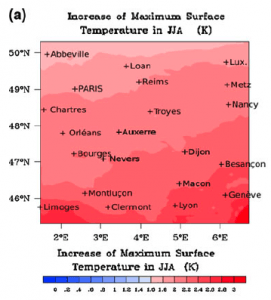l’article du mois – mai 2012
 Burgundy regional climate change and its potential impact on grapevines
Burgundy regional climate change and its potential impact on grapevines
Publié en ligne sur le site de la revue Climate Dynamics
ARPEGE general circulation model simulations were dynamically downscaled by The Weather Research and Forecasting Model (WRF) for the study of climate change and its impact on grapevine growth in Burgundy region in France by the mid twenty-first century. Two time periods were selected: 1970–1979 and 2031–2040. The WRF model driven by ERA-INTERIM reanalysis data was validated against in situ surface temperature observations. The daily maximum and minimum surface temperature (Tmax and Tmin) were simulated by the WRF model at 8 9 8 km horizontal resolution. The averaged daily Tmax for each month during 1970–1979 have good agreement with observations, the averaged daily Tmin have a warm bias about 1–2 K. The daily Tmax and Tmin for each month (domain averaged) during 2031–2040 show a general increase. The largest increment (~ 3 K) was found in summer. The smallest increments (<1 K) were found in spring and fall. The spatial distribution of temperature increment shows a strong meridional gradient, high in south in summer, reversing in winter. The resulting potential warming rate in summer is equivalent to 4.7 K/ century under the IPCC A2 emission scenario. The dynamically downscaled Tmax and Tmin were used to simulate the grape (Pinot noir grape variety) flowering and véraison dates. For 2031–2040, the projected dates are 8 and 12 days earlier than those during 1970–1979, respectively. The simulated hot days increase more than 50% in the two principal grapevine regions. They show strong impact on Pinot noir development.
- extrait:
- lien_externe:
- kc_data:
- a:8:{i:0;s:0:"";s:4:"mode";s:0:"";s:3:"css";s:0:"";s:9:"max_width";s:0:"";s:7:"classes";s:0:"";s:9:"thumbnail";s:0:"";s:9:"collapsed";s:0:"";s:9:"optimized";s:0:"";}
- kc_raw_content:
 Burgundy regional climate change and its potential impact on grapevinespar Yiwen Xu, Thierry Castel, Yves Richard, Cédric Cuccia et Benjamin Bois (CRC)
Burgundy regional climate change and its potential impact on grapevinespar Yiwen Xu, Thierry Castel, Yves Richard, Cédric Cuccia et Benjamin Bois (CRC)Publié en ligne sur le site de la revue Climate Dynamics
ARPEGE general circulation model simulations were dynamically downscaled by The Weather Research and Forecasting Model (WRF) for the study of climate change and its impact on grapevine growth in Burgundy region in France by the mid twenty-first century. Two time periods were selected: 1970–1979 and 2031–2040. The WRF model driven by ERA-INTERIM reanalysis data was validated against in situ surface temperature observations. The daily maximum and minimum surface temperature (Tmax and Tmin) were simulated by the WRF model at 8 9 8 km horizontal resolution. The averaged daily Tmax for each month during 1970–1979 have good agreement with observations, the averaged daily Tmin have a warm bias about 1–2 K. The daily Tmax and Tmin for each month (domain averaged) during 2031–2040 show a general increase. The largest increment (~ 3 K) was found in summer. The smallest increments (<1 K) were found in spring and fall. The spatial distribution of temperature increment shows a strong meridional gradient, high in south in summer, reversing in winter. The resulting potential warming rate in summer is equivalent to 4.7 K/ century under the IPCC A2 emission scenario. The dynamically downscaled Tmax and Tmin were used to simulate the grape (Pinot noir grape variety) flowering and véraison dates. For 2031–2040, the projected dates are 8 and 12 days earlier than those during 1970–1979, respectively. The simulated hot days increase more than 50% in the two principal grapevine regions. They show strong impact on Pinot noir development.
